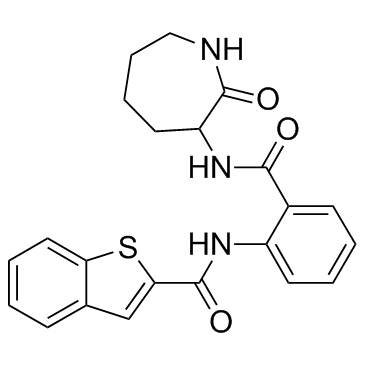| Description |
ANA-12 is a potent and selective TrkB antagonist with IC50s of 45.6 nM and 41.1 μM for the high and low affinity sites, respectively.
|
| Related Catalog |
|
| In Vitro |
ANA-12 (10 nM) prevents BDNF-induced neurite outgrowth in the TrkB-expressing cells, and completely abolishes the effects of BDNF at concentrations up to 10-100 μM[1].
|
| In Vivo |
ANA-12 (0.5 mg/kg, i.p.) partially inhibits the total endogenous TrkB activity in the whole brain of mice. ANA-12, injected in mice, demonstrates anxiolytic and antidepressive activities at 0.5 mg/kg. ANA-12 (0.5, 1.0, and 2.0 mg/kg) does not affect neuron survival[1]. ANA-12 (0.5 mg/kg) shows antidepressant effects in lipopolysaccharide (LPS)-induced depression-like behavior. ANA-12 (0.5 mg/kg) significantly attenuates an increased immobility time in depressed mice. In the TST, FST, and SPT, ANA-12 (0.5 mg/kg) does not show antidepressant-like effects in the control mice[2]. ANA-12 (0.5 mg/kg, i.p.) reverses the diminished self-administration of cocaine in CocSired rats[3].
|
| Animal Admin |
On the day of injection, ketamine (ketamine hydrochloride, 10 mg/kg), 7,8-dihydroxyflavone (7,8-DHF; 10 mg/kg), and ANA-12, N2-(2-{[(2-oxoazepan-3-yl) amino]carbonyl}phenyl)benzo[b]thiophene-2-carboxamide (0.5 mg/kg) are prepared in vehicle of 17 % dimethyl sulfoxide (DMSO) in phosphate-buffered saline. The doses of ketamine (10 mg/kg), 7,8-DHF (10 mg/kg), and ANA-12 (0.5 mg/kg) are selected. All compounds are administered intraperitoneally (i.p.) to mice.
|
| References |
[1]. Cazorla M, et al. Identification of a low-molecular weight TrkB antagonist with anxiolytic and antidepressant activity in mice. J Clin Invest. 2011 May;121(5):1846-57. [2]. Zhang JC, et al. Comparison of ketamine, 7,8-dihydroxyflavone, and ANA-12 antidepressant effects in the social defeat stress model of depression. Psychopharmacology (Berl). 2015 Dec;232(23):4325-35. [3]. Vassoler FM, et al. Epigenetic inheritance of a cocaine-resistance phenotype. Nat Neurosci. 2013 Jan;16(1):42-7. [4]. Fang X, et al. Brain-derived neurotrophic factor-TrkB signaling in the medial prefrontal cortex plays a role in the anhedonia-like phenotype after spared nerve injury. Eur Arch Psychiatry Clin Neurosci. 2018 Jun 7.
|

